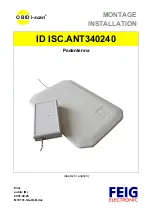
Device Description HG G-71910-C | English, Revision 03 | Date: 17.09.2019
39
Software – Chapter 6
1.
When using RW transponders, the free high bits are searched for a preset value
(0-F). This value may be preset under
and has to be programmed into the
transponders together with the desired code. If a value > F is entered (e.g. 10),
the monitoring is switched off.
2.
For RO- and RW- transponders, the number of codes to be compared can be
chosen within a range of 0 to 15 under
. If the number of codes is set to 0,
any code is output immediately after detection; 1 effects that the received code
is compared to precisely the one detected before, etc.
Please note that the
maximum crossing speed decreases,
as the necessary transmission dura
-
tion increases (n+1) x 8 ms.
determines at which voltage
S
the decoding starts, in order to avoid trials to de
-
code a too weak signal, if necessary.
defines whether the parallel code output is deleted as soon as the transponder
leaves the antenna field.
You can adjust the duration of the positioning pulse (
) and the duration of the
Data-Ready pulse DTR (
) in 1 ms steps. The DTR Setup Time (
) defines the
amount of time that lies between the generation of the parallel code and the output
of the DTR pulse (please refer to section 9.7 „Timing-Diagramm of the Parallel Inter
face“ on page 53 in the appendix).
determines if only one transponder generates a DTR pulse by a new code (1) or
if transponders – after leaving the detection area and reentering this area once again
– are generating a DTR pulse once again (0).
determines at which voltage
S
the positioning pulse is released to avoid wrong
outputs generated by antenna side lopes.
enables the output of a positioning pulse only when a transponder is decoded.
Thus it is possible to avoid wrong positioning pulses in areas with parasitic frequen
-
cies.
Via
you define whether each crossing of the antenna center generates a position
-
ing pulse (0; e.g. when switching between forward and backward operation while a
transponder is directly underneath the antenna) or if only one pulse per crossing is
generated (1). In this case the voltage
S
has to drop below the calculation threshold
to generate a pulse for the same transponder again (Level for Positioning; see 6.3.2.4
on page 38).
With
you choose when the Posi and Data Ready pulses are deleted:
(1) The pulses are deleted when the respective timers from
and
expire
(see above).
(0) The pulses are deleted as soon as the bit TRANS_IN_FIELD falls away (see
Table 7 on page 19).
















































